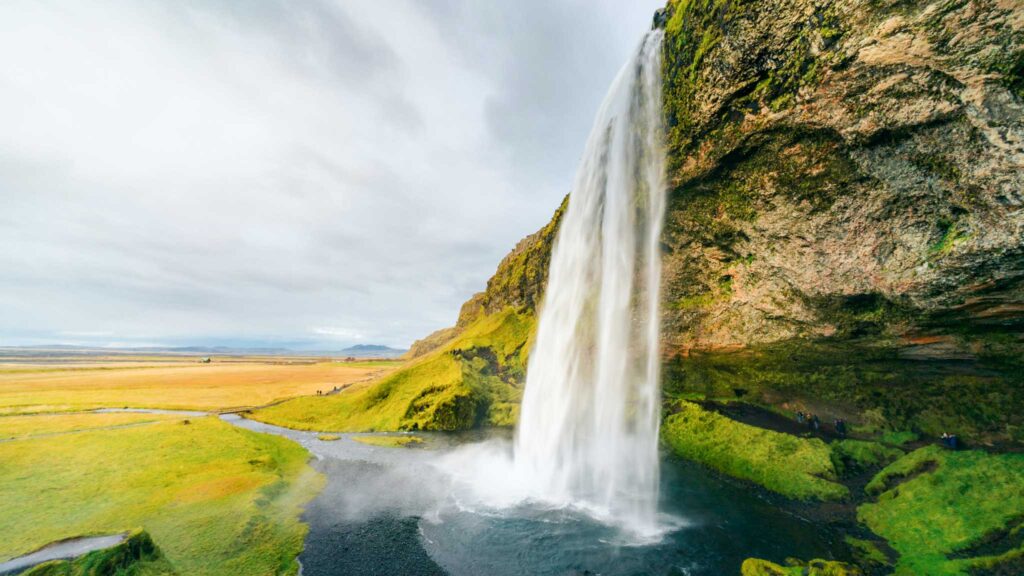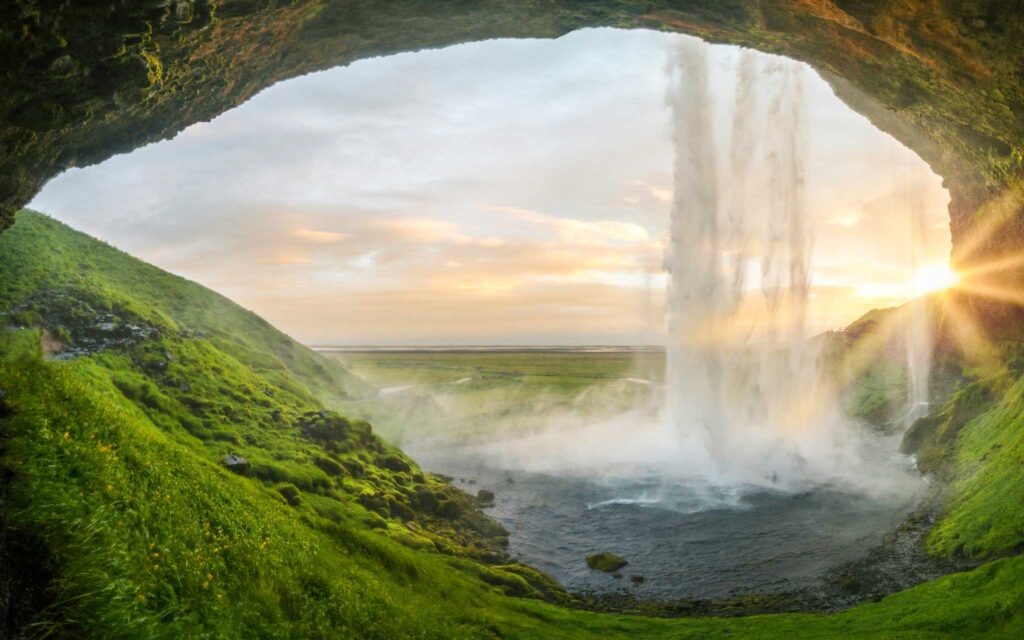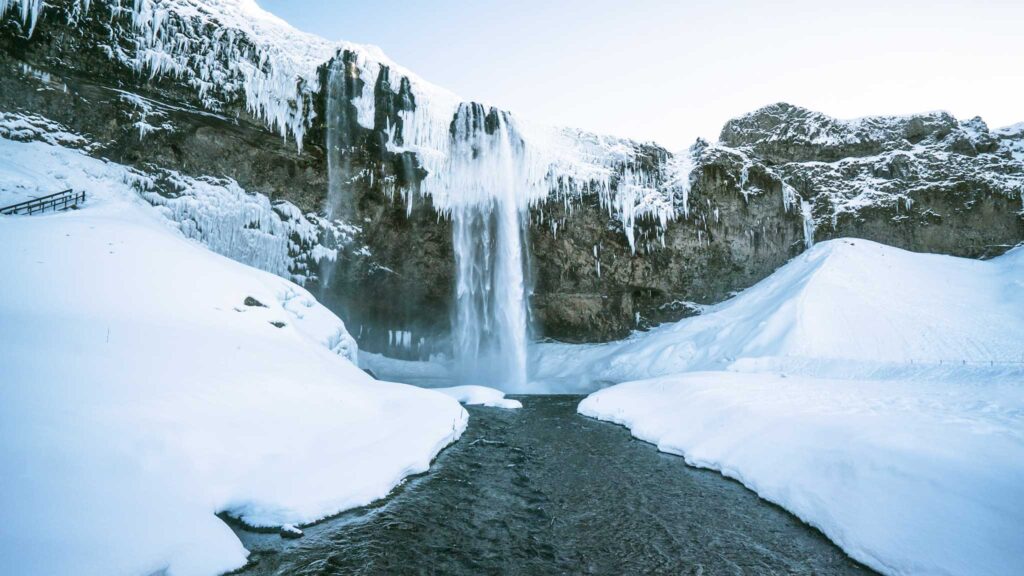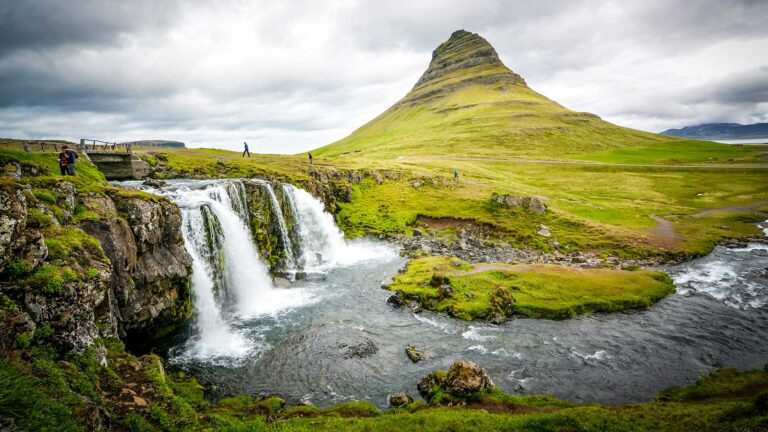With water spilling from every corner of the country, Iceland is home to some of the most stunning waterfalls in the world and Seljalandsfoss is the perfect example. In this guide, we’ll help you plan the perfect trip to Seljalandsfoss waterfall, covering the best times to visit and some awesome travel tips so you can make the most of your adventure.
About Seljalandsfoss Waterfall
Seljalandsfoss waterfall is without a doubt one of the best waterfalls in Iceland and is definitely a must-see for anyone visiting Iceland. The waterfall itself features a 60 metre (197 feet) drop off a cliff which used to mark the former Icelandic South Coast. It’s part of the Seljalandsa river and is fed by melting water from the Eyjafjallajokull glacier which, despite its well known name (due to the 2010 volcanic eruption) is actually one of the smaller glaciers in Iceland.
But what makes it so special, you ask? Well, Seljalandsfoss might not be the tallest waterfall in Iceland, but it’s certainly one of the most unique. It’s famously known as one of the few waterfalls that you can actually walk behind!

How to get to Seljalandsfoss
One of the best things about Seljalandsfoss waterfall is that it’s pretty easy to get to. It’s located on the South Coast of Iceland just off of Route 1 (Iceland’s Ring Road), about 120 kilometres (75 miles) from the capital city of Reykjavik.
Many tour companies offer guided day trips from Reykjavik which also stop off at other must-see places like Skogafoss waterfall.
That said, there’s no better way of visiting Iceland than on a road trip, driving yourself around the country. The drive there typically takes about 2 hrs, though you’ll probably find it takes longer as you’ll be stopping off at all the incredible places on the way. The roads are generally well maintained and should be clear even in winter. However, winter driving can be challenging so be sure to check road conditions and weather forecasts before you set off and drive carefully.
Parking & Facilities at Seljalandsfoss
Facilities at Seljalandsfoss have come a long way since I first visited back in 2016 and we had the entire place to ourselves. Now, Seljalandsfoss has a paid car park. Parking is paid for online and costs around 1,000 kr or the equivalent of £5-6. You’ll also find some basic facilities like free public toilets and a small souvenir shop.
There’s also been talk about a project to build a visitor centre at Seljalandsfoss, but it’s been met with a lot of objections from the locals who argue that a visitor centre would ruin the natural beauty of the waterfall’s site. And we certainly agree having seen this stunning waterfall before it became so popular.
Best time to visit Seljalandsfoss
One of the best things about Seljalandsfoss waterfall is that there isn’t really a bad time to visit. Summer, winter or sometime in between, you can rest assured that Seljalandsfoss will be a sight to behold even during the off-season. And with it being so close to Iceland’s Ring Road, it’s so easily accessible that it’s worth a visit, even during the coldest winter months. Here’s what to expect in each season at Seljalandsfoss:
Seljalandsfoss in Spring
As the ice on the glaciers begins to melt, Iceland’s waterfalls roar. Spring is when Seljalandsfoss will be at its strongest. It will also be just before the peak summer months, you’ll have smaller crowds to deal with while getting many of the benefits of visiting in summer.
Seljalandsfoss in Summer
During the summer months, the hills and fields around Seljalandsfoss are covered in lush green grass and wildflowers as far as the eye can see. And with daylight hours to spare and fantastic weather for hiking and other outdoor adventures, it’s peak time when it comes to visiting Seljalandsfoss. Especially because it’s the time of year when you’ll be able to witness Iceland’s Midnight Sun set over the horizon, right behind the waterfall. That said, it’s the busiest time of year at Seljalandsfoss, so be sure to visit early in the day or late at night when you’re less likely to encounter tourists on guided tours.

Seljalandsfoss in Autumn
In autumn, both the daylight and the colours begin to fade and the vibrant summer greens become more orange and brown which add a completely different look to the waterfall. Autumn is also the quiet season, so there will be significantly fewer tourists and you might just have the place to yourself.
Seljalandsfoss in Winter
In winter, Iceland becomes a winter wonderland and Seljalandsfoss becomes just one of the planet’s works of art. Covered in snow, parts of the waterfall freeze over and give the entire place an absolutely breathtaking look. Just keep in mind that you may not be able to walk behind the waterfall (due to the paths being frozen over), but it’s still well worth the trip!

Top tips for visiting Seljalandsfoss
- Visit early or late: Seljalandsfoss is one of the most popular waterfalls in Iceland so it can often get overcrowded. It’s especially the case when busloads of tourists start to arrive during the later morning and early afternoon. Be sure to get there early or late in the day to avoid the crowds.
- Bring a raincoat: You’re definitely going to get wet, so why not just embrace it! Bring a raincoat and even waterproof trousers if you have them (or at least a change of clothes).
- Come back at night: Seljalandsfoss waterfall is lit up at night so it’s worth coming back after dark if you get the chance!
- Check out Gljufrabui waterfall: While you’re at Seljalandsfoss, be sure to check out Gljufrabui waterfall which is just a short 10-15 min walk from the main car park. It’s a much smaller waterfall but it’s tucked away in a canyon so it feels a lot more like a hidden waterfall than Seljalandsfoss.
And that’s it! There’s everything you need to know to plan your trip to Seljalandsfoss waterfall and make your Icelandic adventures unforgettable!




